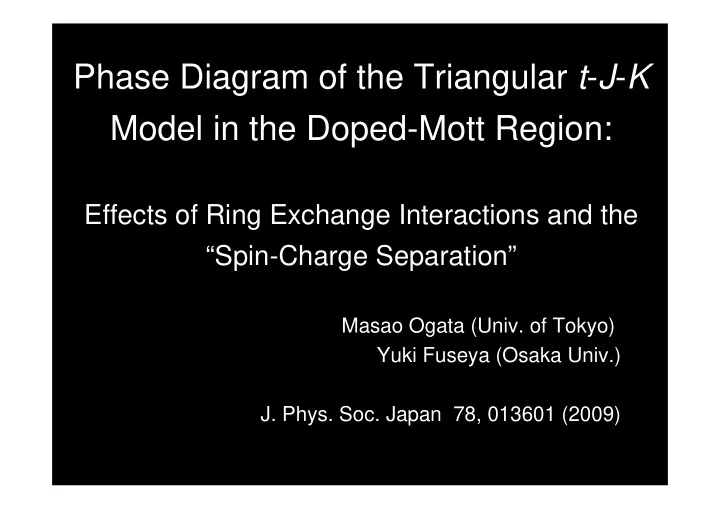

Phase Diagram of the Triangular t - J - K Model in the Doped-Mott Region: Effects of Ring Exchange Interactions and the “Spin-Charge Separation” Masao Ogata (Univ. of Tokyo) Yuki Fuseya (Osaka Univ.) J. Phys. Soc. Japan 78, 013601 (2009)
3 He adsorbed on graphite monolayer 3 He → 3 He, 4 He, HD/HD → graphite → Triangular lattice localization at ‘‘half-filling’’ “4/7 phase” 2D 3 He : underlayer Strongly correlated Fermion system = 4 : 7 [Elser (1989)] Purely two-dimensional Super Clean
Double-peaked heat capacity Spin Mass? “separate”? Spin degrees of freedom + Mass degrees of freedom Spin-‘‘Charge’’ separation Localized 4/7 phase: half-filling 3 He/ 4 He/gr, [Matsumoto, et al. (2007)]
Spin-Charge separation in 1-dim Tomonaga-Luttinger liquid t (a) (c) J (d) (b) In 2-dim ---- movement of a hole leaves trace of Unfovored spin states spin - charge binding Fermi Liquid
t-J model as a model for 3 He A model of monolayer 3 He in the doped case Large U Hubbard model = t-J model in a triangular lattice ------- Frustration However, no spin-charge separation was observed in the triangular t-J model. (Koretsune-Ogata, PRL 89, 116401 (2002))
Multiple Spin Exchange MSE is relevant in a hard-core quantum solid --- Thouless (1965) J 3 J 2 J 4 J 6 J 5 119 36.6 22.5 12.6 6.6 [Bernu et al. (1992)]
t-J-K model As a minimum model of monolayer 3 He, we use t-J - K model J = J 2 -2 J 3 ( J can be ferro. for large J 3 ) hopping exchange t J MSE K
Cluster Exact diagonalization Na =12 1 2 3 4 5 6 7 1 2 3 1 2 3 8 9 10 4 5 6 7 11 12 4 5 6 7 8 9 10 8 9 10 1 2 3 11 12 4 5 6 7 11 12 1 2 3 8 9 10 1 2 3 Na =18b 4 5 6 7 11 12 4 5 6 7 8 9 10 1 2 3 8 9 10 1 2 3 4 11 12 4 5 6 7 11 12 1 2 3 4 5 6 7 8 9 8 9 10 5 6 7 8 9 10 11 12 13 11 12 Na =18a 13 14 1 2 3 10 11 12 15 16 17 18 4 15 16 17 18 1 2 3 4 5 6 7 8 9 1 2 3 4 5 6 1 2 3 4 5 6 1 2 3 1 2 3 4 5 6 7 8 9 10 11 12 13 14 10 11 12 7 8 9 10 11 12 7 8 9 7 8 9 8 9 10 14 15 16 17 18 5 6 7 11 12 13 14 15 16 17 18 13 14 15 16 17 18 13 14 15 16 10 11 12 13 14 15 16 17 18 1 2 3 4 2 3 4 5 6 1 2 3 4 5 6 1 2 3 4 15 16 17 18 1 2 3 4 5 6 7 8 9 9 10 11 12 7 8 9 10 11 12 7 8 9 10 11 5 6 7 8 9 10 11 12 13 14 18 13 14 18 13 14 15 16 17 15 16 17 15 16 17 10 11 12 13 14 15 16 17 18 4 5 6 1 2 3 4 5 6 1 2 3 4 5 6 15 16 17 18 10 11 12 7 8 9 10 11 12 7 8 9 10 11 12 17 18 13 14 15 16 17 18 13 14 15 16 17 18
Half filling (n=1.0) Misguich et al. • N =12,18,20 • Cluster shape Momoi et al. • Boundary • E -level LiMing et al. • s • (comp.) • S(q), N(q) cf) 36 site Misguich, et al (1999) LiMing, et al (2000) Momoi et al (2006)
Doped region (n=0.9)
Excitation energy ordinary cf ) Fermi liquid phase-II Fermi Liquid region (FL) phase-III S(q) and N(q) are consistent with Fermi surface (new QL)
Excitation energy ordinary cf ) Fermi liquid phase-II (FL) cf ) 1D t-J phase-III (new QL)
Spin-Charge separation in 1-dim Tomonaga-Luttinger liquid t (a) (c) J (d) (b) Similar situation can be considered in the t-J-K model !
4-site cluster S=0 S=1 E K=-J K=- 2 J K J S=1 S=1 3 J S=2 S=2 S=1 5 J K (ring) dominant case IV III II J (<0) dominant case (Ferro)
Plaquette approximation K -dominant case SL-I RVB: uuud dddu dddu uuud uuud dddu uuud = uuud u3d1 state
uuu0 uud0 Hole-doped plaquette hole dope uuud
Plaquette approximation K -dominant case Hole doping hopping uuud uuu 0 dddu uuud uuuu ddd 0 uuud
Plaquette approximation hopping uuu 0 dddu uuud uuuu ddd 0 uuud uuuu dddd uuu 0 hole motion Unfavored spin states remains. spin-charge binding: Fermi liquid
Plaquette approximation J-K -competing case uuud uuuu almost degenerate Hole doping
Plaquette approximation J-K -competing case uuud uuuu Hole doping hopping uuud dddu uuud uuu 0 uuuu dddd uuuu uuud uuud ddd 0 uuuu uuuu
Plaquette approximation hopping hopping dddu uuud uuu 0 dddd uuuu uuud uuud ddd 0 uuud uuuu dddu uuuu uuu 0 uuuu dddd hole motion No trace of spin spin-charge separation as in 1-dim : new state
Spin-Charge separation in 1-dim Tomonaga-Luttinger liquid t (a) (c) J (d) (b) Similar situation in the t-J-K model
Summary Fuseya-Ogata: arXiv: 0804.4329 (JPSJ 78, 013601 (2009)) Doping dependence will be OK. • Triangular t-J-K model (exact diagonalization, up to 20 site) • New state (between Ferro and Fermi liquid) • Spin-charge separation ( J vs. K , consistent with 2D 3 He double peak in C)
Recommend
More recommend